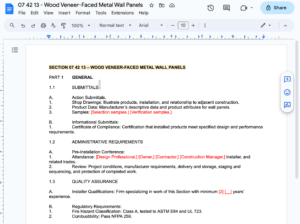CSI Specifications for Construction
Ah, CSI specifications for construction. The easiest way to communicate the requirements, materials, and standards on a construction project.
The terms “construction drawings” and “construction specs” are often used interchangeably. The specifications and drawings are both contract documents. The drawings provide visuals, and specifications are written documents to define the project for pricing, regulatory approvals, and construction purposes.
CSI Construction specifications are the industry standard for commercial construction projects. They were developed as a standard by the Construction Specifications Institute (not the American Institute of Architects), established in 1948.
CSI construction specifications are the industry standard for commercial construction projects. Who writes them and why?
They are created by architects, engineers, and other construction professionals. They are required to have a certain level of knowledge of the type of project they’re working on and a detailed understanding of the materials that will be used on that project.
In general, the organization or design professional designing a building or facility is responsible for writing the construction specifications, even if they don’t actually do it themselves. If you want to write your construction specifications, you can use the same process: gather information about what you want to be built and create an outline of the requirements for your project.
Companies like ZeroDocs, MasterSpec, and Speclink provide construction specification templates (often called master specifications systems) and forms so that Architects can easily create their documents. These templates are free to use but require a subscription to access them.
How are they organized, and what is CSI MasterFormat?
The Construction Specifications Institute (CSI) MasterFormat is the most widely used standard, sometimes referred to as the “Dewey Decimal System” of building construction.
It provides a master list of Divisions, and Section numbers with associated titles within each Division, to organize information about a facility’s construction requirements and related activities. They were published by the Construction Specifications Institute (CSI), a standards organization based in the United States.
It provides a consistent way to classify information about construction projects to be easily shared among different parties, including architects, engineers, contractors, suppliers, and subcontractors.
What is a specification writer or spec writer?
A specifier is often used to describe a person who writes specifications. A specification writer is a person who creates requirements and assists in the design, product evaluation, and selection. They prepare clear, concise, correct, and complete written design and construction documents for a project.
Construction specification writing is a specialized skill. Specification writers must be able to take what they know about the project and put it into terms that are clear, concise, and understandable by anyone who reads them.
Therefore, a specification writer has experience in the field, a degree in Architecture, a construction document technologist (CDT), or certified construction specifier (CCS) accreditation.
Specification writers work as in-house employees at architectural firms and as independent specification consultants for many architectural firms. They are also employed at companies that develop master specification systems.
What is a master specifications system?
A master specifications system is a tool that helps organizations develop, store, and manage 3-part specifications.
The goal of a master specifications system is to make it easier for specifiers to produce specifications for construction projects. Using a master system, you can ensure that you’re always working with the most current performance, reference standards, products, and descriptive specifications for a project.
What is a 3-part specification?
The 3-part specification is the cornerstone of the construction industry, and there’s no substitute in North America for commercial projects. It uses and PageFormat, a recommended style guide for presenting the titles and content of construction specifications sections.
Every 3-part specification includes the below standard arrangement:
1) Part 1: General includes administrative and procedural requirements unique to the section, expanding on subjects covered in Division 01 and adding information unique to the section.
2) Part 2: Products include administrative and procedural requirements unique to the section, expanding on subjects covered in Division 01 and adding information unique to the section.
3) Part 3: Execution, which includes field/site installation requirements or application, including preparatory actions and post-installation cleaning and protection.
Why are 3-part specifications used?
- They’re easy to use. You don’t need special training or expertise to understand the terminology or document format.
- It works well to specify mechanical, electrical, plumbing, and architectural projects. Especially if you’re working in an environment where multiple companies work together on a project.
- It can be used for any construction project—from large residential projects to commercial office buildings!
Why would a project need a set of construction specs?
Construction specs are the detailed requirements that contractors use to build a project. They define the project for pricing, regulatory approvals, and construction purposes. Also, products, equipment, materials, warranties, and operations can be found in the specifications.
Specifications ensure that a project follows the owner’s and design team’s vision. It’s important to know what the contractor will be installing and what project estimates are based upon.
If you’re planning on building something new or renovating an existing building, construction specs are critical to making sure that your vision comes through in the finished product.
What are the different types of construction specification languages?
Specifications use four types of languages in 3-part specifications. Specifiers use descriptive, performance, reference standards, and proprietary, or a combination of each to develop a specification.
Descriptive: Describe the physical and/or chemical properties that the materials should have, the standards they should conform to, and the methods of installation or application.
Performance: A statement of required results. The desired end result must be spelled out. (Example – Adhesion strength of 500psi)
Reference Standard: A standard that is produced by trade associations, professional societies, governments, and institutional organizations. (Example – Installation in accordance with ASTM C XXXX)
Proprietary: Identify the desired product by manufacturer’s name, brand name, model number, and other unique properties. When a single manufacturer meets the requirements specified.
Construction specs help teams communicate and avoid conflicts.
Specifications help teams understand the project and its requirements. They allow the construction team to communicate on cost estimates, the scope of work, potential conflicts, and design intents.
Specifications should be as clear and concise as possible so that everyone in the project can understand the requirements.
Conclusion
At its core, the purpose of construction specifications is to ensure that all parties are clear on what they are committing to. What do they expect from each other—in terms of quality and performance throughout construction.
Specifications are a part of the legal contract for construction agreement between the owner and the contractor is executed.
They’re helpful for anyone who’s involved in the project at some point, like subcontractors and distributors. It clearly describes the work and the rights, duties, and responsibilities of the parties for delivering good work.



